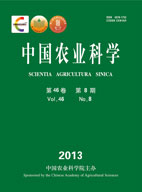-
Effects of Plant and Row Allocation on Population Light Environment and Lodging Resistance of Strip Sown Wheat in Drill
- ZHENG Ting, CHEN Yi, FAN Gao-Qiong, LI Jin-Gang, LI Chao-Su, RONG Xiao-Jiao, LI Guo-Rui, YANG Wen-Yu, GUO Xiang
-
Scientia Agricultura Sinica. 2013, 46(8):
1571-1582.
doi:10.3864/j.issn.0578-1752.2013.08.006
-
 Abstract
(
746 )
Abstract
(
746 )
 PDF (759KB)
(
783
)
PDF (759KB)
(
783
)
 Save
Save
-
References |
Related Articles |
Metrics
【Objective】 The objective of this study was to screen an optimum plant and row space allocation pattern for mechanical strip sown wheat with high yield and lodging resistance in hilly regions of Sichuan.【Method】Two-factor split-plot design was applied in an experiment. The main-plot was two plant-type wheat cultivars, Chuannong 27 of compact-short and Mianmai 367 of intermediate type, and the sub-plot was seven plant and row allocation patterns with different numbers of rows and row spacing under 2 m wide strip type and 150×104 hm-2 planting density unchanged condition. The traditional double-three-zero strip planting pattern, planting five rows with row spacing of 20 cm+20 cm+20 cm+20 cm in a strip, as the CK. F3-1, F3-2 and F3-3 indicated planting three rows with row spacing of 30 cm+30 cm, 35 cm+35 cm and 40 cm+40 cm, respectively. F4-1, F4-2 and F4-3 indicated planting four rows with row spacing of 20 cm+20 cm+20 cm, 20 cm+30 cm+20 cm and 20 cm+40 cm+20 cm in a strip, respectively. The effects of reducing the number of planting rows and widening row spacing on light transmission rate, lodging resistance and yield were investigated, and the correlation of light transmission rate with lodging resistance was analyzed.【Result】Two wheat cultivars demonstrated consistently. Lodging resistance of edge row was significantly higher than that of inner row, and lodging resistance of inner row was positively correlated with light transmission rate. After reducing the number of planting rows from 5 to 4 or 3 and widening row spacing, light transmission rate was significantly improved, and lodging-resistance of edge row and inner row were enhanced, too, especial for the inner row. The related lodging resistance index of inner row indicated that plant height and height of gravity centre decreased, and the second basal culm internode became shorter and thicker, meanwhile, dry weight per stem, wall-thickness, mechanical strength, culm dry density, culm filling degree, the cellulose and lignin content increased, while lodging index decreased. Furthermore, the border advantage was cut down, and the expression of lodging resistance showed well in field test. Besides, spike number and yield increased. The edge row of CK had the best culm quality and the strongest lodging resistance, but the light transmission rate was the lowest, and culm quality of inner row showed serious deterioration, especial for the middle row. What’s more, CK demonstrated the strongest border advantage and the highest lodging odds in field test. In addition, the yield of CK was lower than that of F3-3 and F4-3, and was equivalent to that of F3-2 and F4-2.【Conclusion】Therefore, the allocation pattern, planting three rows with row spacing of 40 cm+40 cm or planting four rows with row spacing of 20 cm+40 cm+20 cm in a strip, is the optimum plant and row allocation pattern for mechanical sowing strip wheat with high yield and lodging resistance in hilly regions of Sichuan, and the allocation pattern, planting three rows with row spacing of 35 cm+35 cm or planting four rows with row spacing of 20 cm+30 cm+20 cm in a strip, is the second. On the whole, the above four patterns can replace the traditional double-three-zero strip planting pattern.









